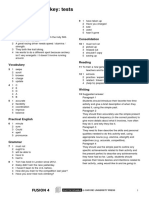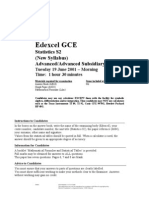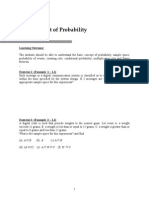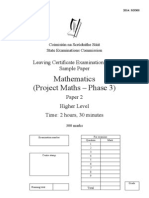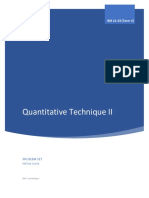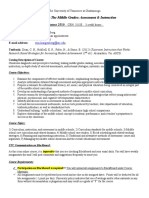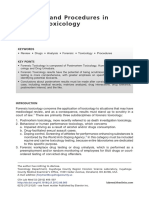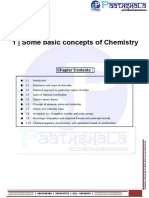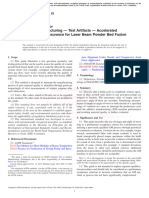Statistics Module S3: GCE Examinations
Statistics Module S3: GCE Examinations
Uploaded by
krackyournutCopyright:
Available Formats
Statistics Module S3: GCE Examinations
Statistics Module S3: GCE Examinations
Uploaded by
krackyournutOriginal Title
Copyright
Available Formats
Share this document
Did you find this document useful?
Is this content inappropriate?
Copyright:
Available Formats
Statistics Module S3: GCE Examinations
Statistics Module S3: GCE Examinations
Uploaded by
krackyournutCopyright:
Available Formats
GCE Examinations
Statistics Module S3
Advanced Subsidiary / Advanced Level
Paper C
Time: 1 hour 30 minutes
Instructions and Information
Candidates may use any calculator except those with a facility for symbolic algebra and / or calculus. Full marks may be obtained for answers to ALL questions. Mathematical and statistical formulae and tables are available. This paper has 8 questions.
Advice to Candidates
You must show sufficient working to make your methods clear to an examiner. Answers without working will gain no credit.
Written by Shaun Armstrong & Chris Huffer
Solomon Press
These sheets may be copied for use solely by the purchasers institute.
1.
A researcher wishes to take a sample of size 9, without replacement, from a list of 72 people involved in the trial of a new computer keyboard. She numbers the people from 01 to 72 and uses the table of random numbers given in the formula book. She starts with the left-hand side of the sixth row of the table and works across the row. The first two numbers she writes down are 56 and 32. (a) (b) Find the other six numbers in the sample. (3 marks)
Give one advantage and one disadvantage of using random numbers when taking a sample. (2 marks)
2.
The length of time that registered customers spend on each visit to a supermarkets website is normally distributed with a mean of 28.5 minutes and a standard deviation of 7.2 minutes. Eight visitors to the site are selected at random and the length of time, T minutes, that each stays is recorded. (a) Write down the distribution ofT, the mean time spent at the site by these eight visitors. (2 marks) (b) Find P(25 <T < 30). (4 marks)
3.
The discrete random variable X has the probability distribution given below. x P(X = x) (a) (b) 2 0.05 4 0.15 7 0.3 k 0.5 (2 marks) (3 marks)
Find the mean of X in terms of k. Find the bias in using ( 2 X 5) as an estimator of k.
Fifty observations of X were made giving a sample mean of 8.34 correct to 3 significant figures. (c) Calculate an unbiased estimate of k. (2 marks)
S3C page 2
Solomon Press
4.
The mass of waste in filled large dustbin bags is normally distributed with a mean of 6.8 kg and a standard deviation of 1.5 kg. The mass of waste in filled small dustbin bags is normally distributed with a mean of 3.2 kg and a standard deviation of 0.6 kg. One week there are 8 large and 3 small dustbin bags left for collection outside a block of flats. Find the probability that this waste has a total mass of more than 70 kg. (7 marks)
5.
For a project, a student is investigating whether more athletic individuals have better hand-eye coordination. He records the time it takes a number of students to complete a task testing coordination skills and notes whether or not they play for a school sports team. His results are as follows: Number of Students In a School Team Not in a Team 50 190 Mean 32.8 s 35.1 s Standard Deviation 4.6 s 8.0 s
Stating your hypotheses clearly, test at the 5% level of significance whether or not there is evidence that those who play in a school team complete the task more quickly on average. (8 marks) 6. Two schools in the same town advertise at the same time for new heads of English and History departments. The number of applicants for each post are shown in the table below. English Highfield School Rowntree School 32 48 History 14 26
Stating your hypotheses clearly, test at the 10% level of significance whether or not there is evidence of the proportion of applicants for each job being different in the two schools. (11 marks)
Turn over
Solomon Press
S3C page 3
7.
A sports scientist wishes to examine the link between resting pulse and fitness. He records the resting pulse, p, of 20 volunteers and the length of time, t minutes, that each one can run comfortably at 4 metres per second on a treadmill. The results are summarised by p = 1176, (a) (b) t = 511, p2 = 70 932, t2 = 19 213, pt = 27 188. (5 marks)
Calculate the product moment correlation coefficient for these data.
Stating your hypotheses clearly, test at the 1% level of significance whether there is evidence of people with a lower resting pulse having a higher level of fitness as measured by the test. (4 marks) State an assumption necessary to carry out the test in part (b) and comment on its validity in this case. (2 marks)
(c)
8.
A physicist believes that the number of particles emitted by a radioactive source with a long half-life can be modelled by a Poisson distribution. She records the number of particles emitted in 80 successive 5-minute periods and her results are shown in the table below. No. of Particles No. of Intervals (a) (b) 0 23 1 32 2 14 3 8 4 3 5 or more 0 (3 marks)
Comment on the suitability of a Poisson distribution for this situation.
Show that an unbiased estimate of the mean number of particles emitted in a 5-minute period is 1.2 and find an unbiased estimate of the variance. (5 marks) Explain how your answers to part (b) support the fitting of a Poisson distribution. (1 mark)
(c)
(d)
Stating your hypotheses clearly and using a 5% level of significance, test whether or not these data can be modelled by a Poisson distribution. (11 marks)
END
S3C page 4
Solomon Press
You might also like
- Fusion 4 Answer KeyDocument48 pagesFusion 4 Answer KeyElisabete Bentivenha44% (9)
- Answ Exam Ibp 07Document16 pagesAnsw Exam Ibp 07Maria Diez BlancoNo ratings yet
- Chapter 3 Lesson 1Document54 pagesChapter 3 Lesson 1Doroty Castro83% (6)
- The Master TheoremDocument11 pagesThe Master TheoremNIKHIL SOLOMON P URK19CS1045No ratings yet
- Geertz - Local Knowledge Critical ReviewDocument6 pagesGeertz - Local Knowledge Critical ReviewlarevoNo ratings yet
- 20 Secret Phrases To Attract and Addict Any Guy You Want!Document23 pages20 Secret Phrases To Attract and Addict Any Guy You Want!Christina Kelly100% (1)
- S2 2001-06Document5 pagesS2 2001-06esraalhamadaniNo ratings yet
- S2 MockDocument5 pagesS2 MockStelios Nicoletti100% (1)
- Mth3003 Tutorial Questions FOR UPM STUDENTS JULY 2010/2011: Please Try All Your Best To Answer All Questions)Document29 pagesMth3003 Tutorial Questions FOR UPM STUDENTS JULY 2010/2011: Please Try All Your Best To Answer All Questions)Ontell Mimi LoloNo ratings yet
- Statistics Module S3: GCE ExaminationsDocument4 pagesStatistics Module S3: GCE ExaminationskrackyournutNo ratings yet
- Edexcel GCE: Tuesday 19 June 2001 Morning Time: 1 Hour 30 MinutesDocument5 pagesEdexcel GCE: Tuesday 19 June 2001 Morning Time: 1 Hour 30 MinutesMohamed NabeelNo ratings yet
- Edexcel GCE: Specimen Paper Time: 1 Hour 30 MinutesDocument5 pagesEdexcel GCE: Specimen Paper Time: 1 Hour 30 MinutesshenzzNo ratings yet
- Solomon B QP - S1 EdexcelDocument4 pagesSolomon B QP - S1 EdexcelabhayNo ratings yet
- MPM 3 SampleDocument1 pageMPM 3 SamplemakoplNo ratings yet
- BS QP ModelDocument12 pagesBS QP ModelArshiya JabeenNo ratings yet
- Past PapersDocument22 pagesPast Paperssameeriqbal737No ratings yet
- Solomon Press S1CDocument5 pagesSolomon Press S1CnmanNo ratings yet
- Solomon Press S1HDocument5 pagesSolomon Press S1HnmanNo ratings yet
- Mte 03Document6 pagesMte 03ghazi4uNo ratings yet
- Math 06Document33 pagesMath 06Ankita HandaNo ratings yet
- Rev QuizDocument4 pagesRev QuiznobuyukiNo ratings yet
- MATH03-CO4-Lesson1-Sampling and Sampling DistributionDocument20 pagesMATH03-CO4-Lesson1-Sampling and Sampling DistributionEdward SnowdenNo ratings yet
- Probability and Stochastic ProcessesDocument5 pagesProbability and Stochastic ProcessesMehran ZahidNo ratings yet
- 2337HW6Document2 pages2337HW6duxingrui0628No ratings yet
- Assignment3 Ans 2015 PDFDocument11 pagesAssignment3 Ans 2015 PDFMohsen FragNo ratings yet
- 13a S1 January 2014Document8 pages13a S1 January 2014xafifaxNo ratings yet
- Faculty of Science, Technology & Environment School of Computing, Information & Mathematical SciencesDocument5 pagesFaculty of Science, Technology & Environment School of Computing, Information & Mathematical SciencesChand DivneshNo ratings yet
- Edexcel s1 Mixed QuestionDocument78 pagesEdexcel s1 Mixed QuestionStylianos_C100% (1)
- S1 Papers To Jan 13Document146 pagesS1 Papers To Jan 13raydenmusicNo ratings yet
- S2 Revision Material PDFDocument15 pagesS2 Revision Material PDFrachitNo ratings yet
- Actuarial Society of India: ExaminationsDocument6 pagesActuarial Society of India: ExaminationsAbdul HadiNo ratings yet
- Mock QP - S1 EdexcelDocument5 pagesMock QP - S1 EdexcelAmeenIbrahim0% (1)
- Solomon A QP - S1 EdexcelDocument4 pagesSolomon A QP - S1 EdexcelabhayNo ratings yet
- MTH 302 Long Questions Solved by Pisces Girl "My Lord! Increase Me in Knowledge."Document20 pagesMTH 302 Long Questions Solved by Pisces Girl "My Lord! Increase Me in Knowledge."Fun NNo ratings yet
- 2011 Math Studies Exam PaperDocument38 pages2011 Math Studies Exam PaperTifeny SengNo ratings yet
- Discrete Probability Distribution QuestionsDocument2 pagesDiscrete Probability Distribution QuestionsShaveta AroraNo ratings yet
- MATH 533 Week 8 Final ExamDocument11 pagesMATH 533 Week 8 Final ExamkimmiekimmieNo ratings yet
- PS 1 Work Book SolutionDocument38 pagesPS 1 Work Book SolutionNur Nadhirah100% (2)
- Sta 305 HW 2Document4 pagesSta 305 HW 2Jasmine NguyenNo ratings yet
- STAT501 Online - Spring2024 - FinalExamDocument14 pagesSTAT501 Online - Spring2024 - FinalExamHarsh Vardhan DubeyNo ratings yet
- Mathematics (Project Maths - Phase 3) : Leaving Certificate Examination 2014 Sample PaperDocument20 pagesMathematics (Project Maths - Phase 3) : Leaving Certificate Examination 2014 Sample PapermaghmathsNo ratings yet
- Waep 2016 Yr12 Apps u34 s1Document12 pagesWaep 2016 Yr12 Apps u34 s1Varad VaidyaNo ratings yet
- ST205 Sample Surveys and ExperimentsDocument2 pagesST205 Sample Surveys and ExperimentsEugene TeoNo ratings yet
- Quiz Descriptive Statistics, Probability & Discrete Probability Distributions Study GuideDocument33 pagesQuiz Descriptive Statistics, Probability & Discrete Probability Distributions Study GuideJacobo DadaNo ratings yet
- Representation of DataDocument27 pagesRepresentation of DataEdgardo LeysaNo ratings yet
- 5.1 HW SolutionsDocument7 pages5.1 HW Solutionssubash1111@gmail.comNo ratings yet
- 6103 B June 2009Document12 pages6103 B June 2009Mazen MoOjaNo ratings yet
- AC - H1 Math 2014Document8 pagesAC - H1 Math 2014ofji4oNo ratings yet
- Edexcel GCE: Statistics S2Document16 pagesEdexcel GCE: Statistics S2Victor ChanNo ratings yet
- Problem Set Solution QT I I 17 DecDocument22 pagesProblem Set Solution QT I I 17 DecPradnya Nikam bj21158No ratings yet
- Advanced StatisticsDocument1 pageAdvanced StatisticsSasam KcNo ratings yet
- Mathlinks8 CH 11textbookDocument26 pagesMathlinks8 CH 11textbookapi-171445363No ratings yet
- Final Examination - April 23, 2013. MATH1014: Name: Surname: Student Number: SignatureDocument17 pagesFinal Examination - April 23, 2013. MATH1014: Name: Surname: Student Number: SignatureexamkillerNo ratings yet
- Business Statistics - Mid Term Set 1-1Document4 pagesBusiness Statistics - Mid Term Set 1-1vinayak mishraNo ratings yet
- Scan 28 Oct 2020Document3 pagesScan 28 Oct 2020anntreesa3010No ratings yet
- Stats 2 Jan 07Document4 pagesStats 2 Jan 07Kyle ByrneNo ratings yet
- A Complete Guide to M.C.Q (Class-10, Mathematics): CBSE MCQ Series, #1From EverandA Complete Guide to M.C.Q (Class-10, Mathematics): CBSE MCQ Series, #1No ratings yet
- Measurement of Length - Screw Gauge (Physics) Question BankFrom EverandMeasurement of Length - Screw Gauge (Physics) Question BankNo ratings yet
- Perfect 800: SAT Math: Advanced Strategies for Top StudentsFrom EverandPerfect 800: SAT Math: Advanced Strategies for Top StudentsRating: 3.5 out of 5 stars3.5/5 (11)
- SAT Math Level 2 Subject Test Practice Problems 2013 EditionFrom EverandSAT Math Level 2 Subject Test Practice Problems 2013 EditionRating: 1 out of 5 stars1/5 (1)
- Bergen County Academies Entrance Practice Tests: Five Full-Length Math and English Essay Tests with Detailed Answer ExplanationsFrom EverandBergen County Academies Entrance Practice Tests: Five Full-Length Math and English Essay Tests with Detailed Answer ExplanationsNo ratings yet
- Yo Yo Its Z in The HouseDocument1 pageYo Yo Its Z in The HousekrackyournutNo ratings yet
- Student Registration Form: Application For Registration ForDocument1 pageStudent Registration Form: Application For Registration ForkrackyournutNo ratings yet
- Probability Questions With SolutionsDocument16 pagesProbability Questions With Solutionskrackyournut100% (1)
- Edexcel A-Level Chemistry Book Answers. Solved by Mr. Takla.Document1 pageEdexcel A-Level Chemistry Book Answers. Solved by Mr. Takla.krackyournutNo ratings yet
- How To Get Android Apps For Free 2013Document1 pageHow To Get Android Apps For Free 2013krackyournutNo ratings yet
- EBP in Adults FinalDocument20 pagesEBP in Adults FinalTony JacobNo ratings yet
- Taryn Snaith: Personal StatementDocument2 pagesTaryn Snaith: Personal Statementapi-495285223No ratings yet
- Form 2 MathsDocument8 pagesForm 2 MathsBenard NjeriNo ratings yet
- G8 PPT Q1W1 D1Document46 pagesG8 PPT Q1W1 D1Danica CanieteNo ratings yet
- Educ-1 4230 31188 Syllabus Su16 3Document7 pagesEduc-1 4230 31188 Syllabus Su16 3api-322744362No ratings yet
- Looks Can Be Deceiving - Published On BroadsheetDocument5 pagesLooks Can Be Deceiving - Published On BroadsheetaznarelaineNo ratings yet
- Session 8 - LTI Systems (III) - ConvolutionDocument19 pagesSession 8 - LTI Systems (III) - ConvolutionjulianNo ratings yet
- PROVIDER Directories v4.6 Certification Test Scenarios 2013 V 1.0Document11 pagesPROVIDER Directories v4.6 Certification Test Scenarios 2013 V 1.0Rabindra P.SinghNo ratings yet
- Force Unleashed 2Document2 pagesForce Unleashed 2Michael Ron Bogart BritschNo ratings yet
- 2007 Coca Cola Enterprise SAP Business Planning and Consolidation NW Version 10 Implementation JourneyDocument18 pages2007 Coca Cola Enterprise SAP Business Planning and Consolidation NW Version 10 Implementation JourneyArpan MahajanNo ratings yet
- Stryker - SDC Ultra - User Manual GuideDocument61 pagesStryker - SDC Ultra - User Manual GuideJoel GrullonNo ratings yet
- Clinics in Laboratory MedicineDocument15 pagesClinics in Laboratory MedicineMárcio RodriguesNo ratings yet
- Q1. What Lessons Your Firm Might Learn About Its Entire ProcessesDocument9 pagesQ1. What Lessons Your Firm Might Learn About Its Entire ProcessesimmacoolcatNo ratings yet
- PGP Command Line 9.0.6 Release NotesDocument9 pagesPGP Command Line 9.0.6 Release NotesLuis Danìel Moo TunNo ratings yet
- Writing Portfolio IntroductionDocument2 pagesWriting Portfolio Introductionapi-445723344No ratings yet
- Noli Me Tangere, Continuing Relevance: Nadal, Vallega, CajuelanDocument15 pagesNoli Me Tangere, Continuing Relevance: Nadal, Vallega, CajuelanRen Owen Immanuel NadalNo ratings yet
- 1101 Some Basic Concepts of Chemistry Entrance PDFDocument25 pages1101 Some Basic Concepts of Chemistry Entrance PDFPaathshala Education ITNo ratings yet
- UNIT 01 Self AssessmentDocument1 pageUNIT 01 Self AssessmentYecidNo ratings yet
- UserGuide Omnetpp4.2bDocument107 pagesUserGuide Omnetpp4.2bTarek AziziNo ratings yet
- Introduction To Philippine HistoryDocument20 pagesIntroduction To Philippine HistoryCatie Raw AyNo ratings yet
- Jour 5 SemDocument14 pagesJour 5 SemFaizy AhsanNo ratings yet
- The Great ArchDocument135 pagesThe Great ArchAngela MarieNo ratings yet
- Astm F3626 23Document3 pagesAstm F3626 23Reginald ElvisNo ratings yet
- 3º Congresso Brasileiro de Túneis e Estruturas Subterrâneas Seminário Internacional "South American Tunnelling - SAT 2012"Document7 pages3º Congresso Brasileiro de Túneis e Estruturas Subterrâneas Seminário Internacional "South American Tunnelling - SAT 2012"MapeixNo ratings yet
- MCS 13 Solved AssignmentDocument21 pagesMCS 13 Solved AssignmentSukhpreet Singh100% (1)
- Prosodic MorphologyDocument9 pagesProsodic MorphologyKayla AgiestaNo ratings yet
